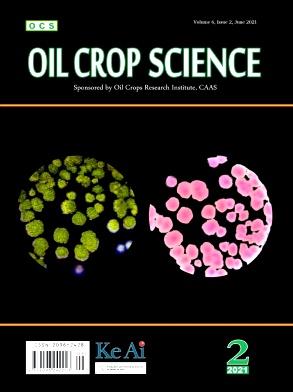Development of KASP markers for FT family genes in soybean
Q3 Agricultural and Biological Sciences
引用次数: 0
Abstract
FLOWERING LOCUS T (FT), a key regulator of photoperiod pathway, plays a pivotal role in modulating flowering time and growth period-related traits in plants. In this study, we identified 10 FT family genes in soybean and examined their functional divergences through sequence alignment analysis. Phylogenetic and amino acid sequence analysis revealed that the 92nd residue and the Segment B domain (sites 129, 131, 134, 135) are the critical determinants of potential functional divergence and activity variation among GmFT. Using the SoyOmics website, we detected natural variations in the genomic and promoter regions of GmFTs, along with numerous haplotypes. By correlating these haplotypes with flowering time, we identified 7 potential KASP markers associated with soybean growth period: GmFT1a-60297360, GmFT1b-60311669, GmFT2a-31695562, GmFT2b-31739433, GmFT3a-4106476, GmFT5a-4078626, and GmFT5b-37490962. All KASP markers exhibited high selection efficiency (97.56%–100.00%) and reliable genotyping accuracy when validated across 82 soybean varieties spanning multiple maturity groups (MGs). This study systematically elucidates the functional divergence of GmFTs and develops efficient KASP markers, providing essential technological support for photoperiod-adaptive breeding and germplasm innovation.
大豆FT家族基因KASP标记的开发
开花位点T (flower LOCUS T, FT)是光周期通路的关键调控因子,在植物开花时间和生长期相关性状的调控中起着关键作用。本研究鉴定了10个大豆FT家族基因,并通过序列比对分析对其功能差异进行了分析。系统发育和氨基酸序列分析表明,第92个残基和B段结构域(129、131、134、135位点)是GmFT潜在功能分化和活性变化的关键决定因素。利用大豆组学网站,我们检测到了GmFTs基因组和启动子区域的自然变异,以及许多单倍型。通过将这些单倍型与开花时间进行关联,我们鉴定出7个与大豆生育期相关的潜在KASP标记:GmFT1a-60297360、GmFT1b-60311669、GmFT2a-31695562、GmFT2b-31739433、GmFT3a-4106476、GmFT5a-4078626和GmFT5b-37490962。在82个大豆品种的多成熟组(mg)中,KASP标记均表现出较高的选择效率(97.56% ~ 100.00%)和可靠的基因分型准确性。该研究系统地阐明了gmft的功能分化,开发了高效的KASP标记,为光周期适应性育种和种质创新提供了必要的技术支持。
本文章由计算机程序翻译,如有差异,请以英文原文为准。
求助全文
约1分钟内获得全文
求助全文
来源期刊

Oil Crop Science
Food Science, Plant Science, Agronomy and Crop Science
CiteScore
3.40
自引率
0.00%
发文量
20
审稿时长
74 days
 求助内容:
求助内容: 应助结果提醒方式:
应助结果提醒方式:


